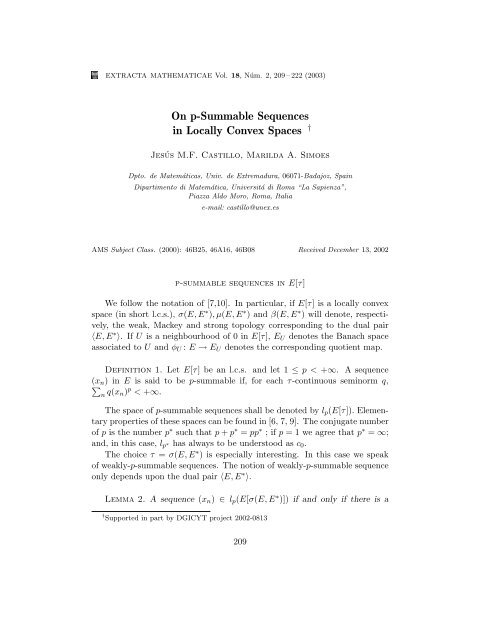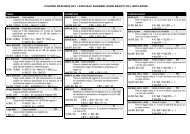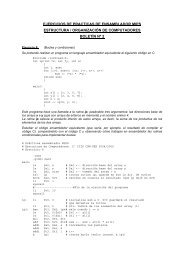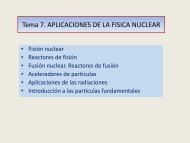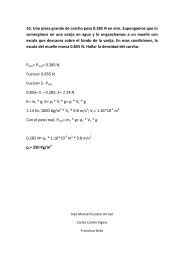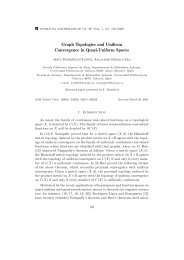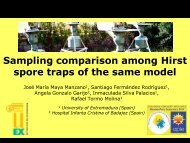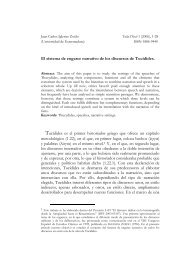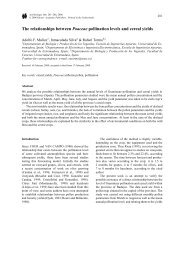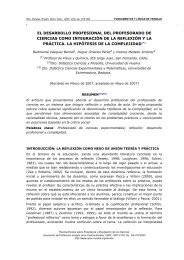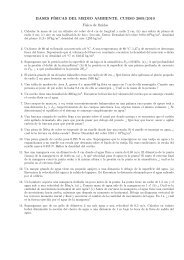On p-Summable Sequences in Locally Convex Spaces â
On p-Summable Sequences in Locally Convex Spaces â
On p-Summable Sequences in Locally Convex Spaces â
You also want an ePaper? Increase the reach of your titles
YUMPU automatically turns print PDFs into web optimized ePapers that Google loves.
E extracta mathematicae Vol. 18, Núm. 2, 209 – 222 (2003)<strong>On</strong> p-<strong>Summable</strong> <strong>Sequences</strong><strong>in</strong> <strong>Locally</strong> <strong>Convex</strong> <strong>Spaces</strong> †Jesús M.F. Castillo, Marilda A. SimoesDpto. de Matemáticas, Univ. de Extremadura, 06071-Badajoz, Spa<strong>in</strong>Dipartimento di Matemática, Universitá di Roma “La Sapienza”,Piazza Aldo Moro, Roma, Italiae-mail: castillo@unex.esAMS Subject Class. (2000): 46B25, 46A16, 46B08 Received December 13, 2002p-summable sequences <strong>in</strong> E[τ]We follow the notation of [7,10]. In particular, if E[τ] is a locally convexspace (<strong>in</strong> short l.c.s.), σ(E, E ∗ ), µ(E, E ∗ ) and β(E, E ∗ ) will denote, respectively,the weak, Mackey and strong topology correspond<strong>in</strong>g to the dual pair〈E, E ∗ 〉. If U is a neighbourhood of 0 <strong>in</strong> E[τ], E U denotes the Banach spaceassociated to U and φ U : E → E U denotes the correspond<strong>in</strong>g quotient map.Def<strong>in</strong>ition 1. Let E[τ] be an l.c.s. and let 1 ≤ p < +∞. A sequence(x n ) <strong>in</strong> E is said to be p-summable if, for each τ-cont<strong>in</strong>uous sem<strong>in</strong>orm q,∑n q(x n) p < +∞.The space of p-summable sequences shall be denoted by l p (E[τ]). Elementaryproperties of these spaces can be found <strong>in</strong> [6, 7, 9]. The conjugate numberof p is the number p ∗ such that p + p ∗ = pp ∗ ; if p = 1 we agree that p ∗ = ∞;and, <strong>in</strong> this case, l p ∗ has always to be understood as c 0 .The choice τ = σ(E, E ∗ ) is especially <strong>in</strong>terest<strong>in</strong>g. In this case we speakof weakly-p-summable sequences. The notion of weakly-p-summable sequenceonly depends upon the dual pair 〈E, E ∗ 〉.Lemma 2. A sequence (x n ) ∈ l p (E[σ(E, E ∗ )]) if and only if there is a† Supported <strong>in</strong> part by DGICYT project 2002-0813209
210 j.m.f. castillo, m.a. simoesβ(E ∗ , E)-neighborhood U of 0 such that∑sup |〈x ∗ , x n 〉| p < +∞.x ∗ ∈UnProof. The sufficiency is evident. To see the necessity, def<strong>in</strong>e the applicationsT n : E ∗ −→ l px ∗ −→ (〈x ∗ , x 1 〉, 〈x ∗ , x 2 〉, . . . , 〈x ∗ , x n 〉, 0, . . . ),which are clearly σ(E ∗ , E)-cont<strong>in</strong>uous. S<strong>in</strong>ce (x n ) is weakly-p-summable, thesequence (T n x ∗ ) is bounded for all x ∗ ∈ E ∗ . Thus, be<strong>in</strong>g the strong topologybarrelled, ∩ n∈NT −1n (B lp ) is a β(E ∗ , E)-neighborhood of 0.A weaker form of Lemma 2 is usually established replac<strong>in</strong>g “β-neighborhood”by “τ- equicont<strong>in</strong>uous set” <strong>in</strong> Lemma 2 (see, e.g.,[6]). A simple characterizationof weakly-p-summable sequences of E[τ] is given by the follow<strong>in</strong>gLemma 3. Let 1 ≤ p < +∞. Let (x n ) be a sequence <strong>in</strong> a locally convexspace E[τ]. The follow<strong>in</strong>g statements are equivalent:1. The sequence (x n ) belongs to l p (E[σ(E, E ∗ )]);2. For each ϕ ∈ l ∗ p, the series ∑ n ϕ nx n is τ-Cauchy;3. For each τ-cont<strong>in</strong>uous sem<strong>in</strong>orm q there exists a constant C q ≥ 0 suchthatq ( ∑ )ϕ n x n ≤ Cq ‖ϕ‖ lp ∗ ,for any f<strong>in</strong>ite set ∆ ⊂ N;n∈∆4. For each τ-neighborhood U of 0, the sequence (φ U (x n )) n belongs to thespace l p (E U [σ(E U , E ∗ U )]).Proof. 1 ⇒ 3. If q denotes a τ-cont<strong>in</strong>uous sem<strong>in</strong>orm,q ( ∑ ) ∣ϕ n x n = sup ∣〈x ∗ , ∑ ϕ n x n 〉 ∣ n∈∆x ∗ ∈Uq◦ n∈∆( ∑≤ sup |〈x ∗ , x n 〉| p) 1/p ‖ϕ‖lpx ∗ ∈Uq◦ ∗ ,n∈∆≤ C q ‖ϕ‖ lp ∗ .
on p-summable sequences 211The equivalence 3 ⇔ 4 is evident. That 3 ⇒ 2 is very easy. That 2 ⇒ 1is clear: s<strong>in</strong>ce 2 implies that, for all x ∗ ∈ X ∗ and all (ϕ n ) ∈ l p ∗, the series∑n ϕ n〈x ∗ , x n 〉 converges, hence (〈x ∗ , x n 〉) ∈ l p .Remark 1. Therefore, a sequence (x n ) belongs to l p (E[σ(E, E ∗ )]) if andonly if the set{ ∑}conv p *(x n ) = θ n x n : ∆ ⊂ N , f<strong>in</strong>ite and (θ n ) ∈ B l ∗ p,n∈∆that shall be called the p ∗ -convex hull of (x n ), is bounded. Thus, all topologieshav<strong>in</strong>g the same bounded sets as σ(E, E ∗ ) have the same weakly-p-summablesequences. Notice that conv p *(x n ) is an absolutely convex set, hence its closureis the same no matter which compatible topology one uses. When p = 1, thenwe set}conv ∞ (x n ) = θ n x n : ∆ ⊂ N , f<strong>in</strong>ite and |(θ n )| ≤ 1 .{ ∑n∈∆Remark 2. S<strong>in</strong>ce the notion of weakly-p-summable sequence depends onlyupon the dual pair, it is possible to replace “τ-Cauchy” <strong>in</strong> 2 by “σ(E, E ∗ )-Cauchy”. Moreover, if E[τ] is quasi-complete, then condition 2 can be replacedby2’. For each ϕ ∈ l p ∗, ∑ n ϕ nx n is τ-convergent,obta<strong>in</strong><strong>in</strong>g thus an identificationL(l p ∗, E[τ]) = l p (E[σ(E, E ∗ )]<strong>in</strong> the form x n = T e n . The dependence upon the dual pair makes it perhapsmore correct refer properties to the Mackey topology. Thus, if E[µ] is quasicomplete,one hasL(l p ∗, E[µ]) = l p (E[σ(E, E ∗ )] = L(l p ∗, E[τ]).Remark 3. A question of some <strong>in</strong>terest by its own f<strong>in</strong>ds an answer <strong>in</strong> thiscontext: recall that if (x n ) is a bounded sequence <strong>in</strong> a Banach space suchthat for all x ∗ of a dense subset of x ∗ , lim〈x ∗ , x n 〉 = 0, then (x n ) is weaklynull. Will this be still true for weakly-p-summable sequences? The answeris no: just consider, for <strong>in</strong>stance, the space l 2 ; the sequence (e n ) is weakly-1-summable for the topology σ(l 2 , l 1 ), l 1 is dense <strong>in</strong> l 2 , but the sequence (e n ) isnot weakly-1-summable <strong>in</strong> l 2 with respect to the norm topology.
212 j.m.f. castillo, m.a. simoesRemark 4. <strong>On</strong> a dual space E ∗ , weakly-p-summable and weakly*-psummablesequences do not necessarily co<strong>in</strong>cide. Weakly-p-summable sequencesare obviously weakly*-p-summable; to obta<strong>in</strong> the converse one wouldneed, follow<strong>in</strong>g Lemma 2, that β(E ∗∗ , E) |E = β(E, E ∗ ). Hence, the two notionsco<strong>in</strong>cide on duals of barrelled, quasi-complete or semi-reflexive spaces.Def<strong>in</strong>ition 4. We say that an application T : E[τ] → F [ρ] is p-convergent,or briefly T ∈ C p (τ, ρ), if it <strong>in</strong>duces an application between the sequence spacesT <strong>in</strong>d : l p (E[τ]) → c 0 (F [ρ]).When p = +∞ then it is understood that the <strong>in</strong>duced application actsfrom c 0 (E[τ]) <strong>in</strong>to c 0 (F [ρ]).Obviously, when T is (τ, ρ)-cont<strong>in</strong>uous then it belongs to C p (τ, ρ). Thus,it is only <strong>in</strong>terest<strong>in</strong>g to know what happens when T is not cont<strong>in</strong>uous. Thema<strong>in</strong> example is the action of the identity id: E[σ(E, E ∗ )] → E[τ], when τ isanother topology compatible with the duality 〈E, E ∗ 〉.Def<strong>in</strong>ition 5. We shall say that E[τ] ∈ C p , 1 ≤ p ≤ +∞, or that E[τ] isa C p -space, if the formal identity id : E[σ(E, E ∗ )] → E[τ] is p-convergent.Remark 5. The property C ∞ is usually called the Schur property.It is clear that subspaces and arbitrary products of C p -spaces are aga<strong>in</strong>C p -spaces. S<strong>in</strong>ce bounded sets <strong>in</strong> locally convex sums are actually conta<strong>in</strong>ed<strong>in</strong> convex hulls of the images of bounded sets <strong>in</strong> a f<strong>in</strong>ite number of factors,Remark 1 yields that a locally convex sum of C p - spaces is a C p -space. Quotientsof C p -spaces need not be C p -spaces (quotients of l 1 for example). Recallthat a property P is said to be a three-space property if whenever Y and X/Yhave P then X has P.Proposition 6. In the class of metrisable spaces, to be a C p -space is athree-space property.Proof. Let (U n ) be a fundamental sequence of neighbourhoods of 0 for ametrisable space F ; we assume that U m + U m ⊂ U m−1 . Let E and F/E be,respectively, a subspace and the correspond<strong>in</strong>g quotient space, and assumethat E and F/E are C p - spaces. Let (x n ) be a weakly-p-summable sequence<strong>in</strong> F. It is clearly enough to obta<strong>in</strong> a convergent subsequence. If Q: F → F/Edenotes the quotient map, (Q(x n )) is a weakly-p-summable sequence <strong>in</strong> F/E
on p-summable sequences 213and, therefore, convergent to 0. This means that, for all m there exists N(m)such that Q(x n ) ⊂ Q(U m ). Thus, for each m there exists N(m) so that ifn ≥ N(m) it is possible to f<strong>in</strong>d y n,m ∈ E such that x n − y n,m ∈ U m .By diagonalisation, and relabell<strong>in</strong>g the <strong>in</strong>dexes if necessary, a new sequence(y n ) can be obta<strong>in</strong>ed such that x n −y n ∈ 2 −n U n , for all n of some subsequence.The sequence (y n ) is as weakly-p-summable <strong>in</strong> E as (x n ) was <strong>in</strong> F : observethat the set conv p *((y n ) n ) is bounded, s<strong>in</strong>ce given a neighborhood U m withm ≥ M and scalars θ i with |θ i | ≤ 1 one hasM+N∑M+1θ i (x i − y i ) ∈M+N∑M+1θ i2 i U i ⊂ 12 M U M ⊂ U M .Thus, the sequence (y n ) is convergent to 0, and so is (x n ).Remark 6. The ideal C p of p-converg<strong>in</strong>g operators <strong>in</strong> Banach spaces, def<strong>in</strong>edas those transform<strong>in</strong>g weakly-p-summable sequences <strong>in</strong>to convergent ones,was <strong>in</strong>troduced and studied <strong>in</strong> [1, 2]. The ideal C p is <strong>in</strong>termediate betweenthe ideals C 1 = U of unconditionally converg<strong>in</strong>g operators (those transform<strong>in</strong>gweakly-1-summable sequences <strong>in</strong>to summable sequences) and the idealC ∞ of completely cont<strong>in</strong>uous or Dunford-Pettis operators (those transform<strong>in</strong>gweakly convergent sequences <strong>in</strong>to convergent sequences). Perhaps the mostnatural examples of such operators are the identities of the spaces l p .Proposition 7. id(l p ) ∈ C r for all r < p ∗ .Proof. Let (x n ) be a weakly-r-summable sequence <strong>in</strong> l p . If it is norm null,we have f<strong>in</strong>ished. If not, an application of the Bessaga-Pelczynski selectionpr<strong>in</strong>ciple yields a subsequence equivalent to certa<strong>in</strong> blocks of the canonicalbasis of l p (recall here that two sequences (x n ) and (y n ) are called equivalentif there is an isomorphism between their closed spans T : [x n ] → [y n ] such thatT x n = y n ). S<strong>in</strong>ce blocks of the canonical basis of l p are weakly-p ∗ -summable,but not weakly-r-summable when r < p ∗ , the proof is complete.It is worth <strong>in</strong>troduc<strong>in</strong>g here the Grothendieck space ideal def<strong>in</strong>ed by theideals C p : a l.c.s. E[τ] ∈ Groth(C p ) if it can be written as a projective limitof C p -operators between the associated Banach spaces. For <strong>in</strong>stance, anyprojective limit of subspaces of l p belongs, for all r < p ∗ , to Groth(C r ); anySchwartz space belongs, for all 1 ≤ r ≤ +∞, to Groth(C r ). It is also clearthat if E[τ] ∈ Groth(C p ) then E[τ] ∈ C p , and an <strong>in</strong>terest<strong>in</strong>g question is under
214 j.m.f. castillo, m.a. simoeswhich hypotheses the converse is also true. We shall show that this is notalways the case:Examples. Let λ p be Köthe’s example of a Fréchet-Montel non Schwartzechelon space of order p, 1 < p < +∞, (see [8, 10]). S<strong>in</strong>ce weakly convergentsequences are convergent <strong>in</strong> Fréchet- Montel spaces, λ p ∈ C r for all r. S<strong>in</strong>ceλ p is a projective limit of the spaces l p , by Proposition 3 λ p ∈ Groth(C r ) forall r < p ∗ . However, one can show (see the proof of Proposition 7) that everyC p ∗-operator on l p is compact; s<strong>in</strong>ce λ p is not a Schwartz space, we concludethat λ p ∈ Groth(C r ) for all r < p ∗ , but not to Groth(C p ∗). There exists amodification of this example [8]: a Fréchet-Montel non Schwartz echelon spaceor order 0, which yields a counterexample for p=1.The Grothendieck space ideal Groth(C p ) has the same stability propertiesas the smallest class of C p -spaces. Moreover,Proposition 8. Groth(C p ) is a three-space class.Proof. Let E be a locally convex space, and let F be a closed subspaceand E/F the correspond<strong>in</strong>g quotient space with quotient map Q: E → E/F.Assume that both E and E/F belong to Groth(C p ). The proof is easy proceed<strong>in</strong>gthis way: Let U be a neighborhood of 0 <strong>in</strong> E. S<strong>in</strong>ce E/F is <strong>in</strong> Groth(C p ),there exists some neighborhood V ⊂ U such that the l<strong>in</strong>k<strong>in</strong>g mapF V → F Uis <strong>in</strong> C p . Then, select another neighborhood W ⊂ V such that the l<strong>in</strong>k<strong>in</strong>gmap(E/F ) Q(W ) → (E/F ) Q(V )is <strong>in</strong> C p . Let now (x n ) be a weakly-p-summable sequence <strong>in</strong> E W . Its image<strong>in</strong> (E/F ) Q(W ) is also weakly-p-summable and thus lim p Q(V ) (x n + F ) = 0.Choos<strong>in</strong>g elements (y n ) <strong>in</strong> F such that p V (x n − y n ) ≤ 2 −n the estimatesup p W ( ∑ n θ nx n ) < ∞ (the supremum taken over all f<strong>in</strong>ite comb<strong>in</strong>ations with(θ n ) <strong>in</strong> the unit ball of l p ∗) yields that the sequence of the images of (y n ) isweakly-p-summable <strong>in</strong> E V . Hence lim p U (y n ) = 0, and lim p U (x n ) = 0.Proposition 9. Let 1 ≤ p < +∞ and let E[τ] be a quasi-complete l.c.s.Then E[τ] ∈ C p if and only if all cont<strong>in</strong>uous operators from l p ∗ <strong>in</strong>to E[τ] arecompact.
on p-summable sequences 215Proof. Necessity (the case p=1 will be treated apart): Let p > 1 andlet T be a cont<strong>in</strong>uous operator T : l p ∗ → E[τ]. Given any bounded sequence(x n ) <strong>in</strong> l p ∗, a po<strong>in</strong>t x and a subsequence (x m ) exist such that (x m − x) isweakly-p-summable (as <strong>in</strong> the proof of Proposition 7). Therefore, the sequence(T (x m −x)) m is weakly-p-summable <strong>in</strong> E[τ], and thus it must be τ-convergentto zero. This means that T (B lp ∗ ) is a relatively sequentially compact set,which <strong>in</strong> a quasi-complete space means relatively compact.Case p = 1 (l p ∗ = c 0 ): Let T be a cont<strong>in</strong>uous operator, T : c 0 → E[τ]. S<strong>in</strong>ceE[τ] ∈ C 1 , for every τ-neighborhood U of 0 the composition φ U T belongs toC 1 (c 0 , E U ) and must be compact. The operator T is necessarily compact.Sufficiency (the case p = 1, l p ∗ = c 0 , is also covered by this argument): Let(x n ) be a weakly- p-summable sequence of E. S<strong>in</strong>ce E[τ] is quasi- complete,the spaces of operators L(l p ∗, E[τ]) and l p (E[σ(E, E ∗ )]) can be identified; thus,x n = T e n for some cont<strong>in</strong>uous operator T : l p ∗ → E[τ] which, by hypothesis,is compact. So, (x n ) is τ- convergent.Remark 7. Regard<strong>in</strong>g Remark 2 and Proposition 9, the Proposition 7 is,essentially, a reformulation of the result known as Pitt’s theorem: All operatorsl p → l q are compact if and only if p > q.The topology µ pIt is clear that the formal identity id: E[σ(E, E ∗ )] → E[τ] belongs to C pfor all p when τ = σ(E, E ∗ ). If τ is replaced by a f<strong>in</strong>er topology, the <strong>in</strong>dex psurely decreases. This observation orig<strong>in</strong>ates the follow<strong>in</strong>g def<strong>in</strong>ition.Def<strong>in</strong>ition 10. Let E[τ] be a locally convex space and let 1 ≤ p < +∞.We shall denote by µ p the topology of the uniform convergence on the p ∗ -convex hull of the weakly*-p-summable sequences of E ∗ .Recall that for quasi-complete spaces E and 1 ≤ p < +∞ it makes nodifference to consider the p ∗ -convex hull of weakly*-p-summable sequences ofE ∗ (see Remark 4). For p = +∞ the topology µ ∞ is the topology of theuniform convergence on the absolutely convex hull of weakly* null sequences<strong>in</strong> E ∗ . It is clear that σ(E, E ∗ ) ≤ µ p (E, E ∗ ) ≤ µ q (E, E ∗ ) ≤ µ ∞ (E, E ∗ ),for 1 ≤ p ≤ q < +∞. In barrelled or, more generally, <strong>in</strong> spaces hav<strong>in</strong>gquasi-complete duals (<strong>in</strong> some compatible topology) the topologies µ p arecompatible: The first assertion directly follows from Lemma 2. To see that
216 j.m.f. castillo, m.a. simoesµ p (E, E ∗ ) ≤ µ(E, E ∗ ), one needs to verify that the p ∗ -convex hull of a weaklyp-summablesequence <strong>in</strong> E ∗ is σ(E ∗ , E)-relatively compact. If the space, say,E ∗ [µ] is quasi-complete, then the closure of that set is the cont<strong>in</strong>uous imageof the unit ball of l p ∗ as described <strong>in</strong> the Remark 2. It is, therefore, weaklycompact. The proof for p = 1 is a consequence of this. In barrelled spaces thetopology µ ∞ is compatible s<strong>in</strong>ce the absolutely convex hull of weakly* nullsequences is a relatively weakly* compact set.If E[τ] does not satisfy any of the hypotheses, then the topologies could benot compatible: consider, for <strong>in</strong>stance, the space l 2 endowed with the Mackeytopology µ(l 2 , ϕ), where ϕ is the countable dimensional space. It turns outthat µ(l 2 , ϕ) is not compatible with µ 2 (l 2 , ϕ) which turns out to be the normtopology.Also, µ ∞ (c 0 , ϕ), the norm topology, is not compatible with µ(c 0 , ϕ).Two <strong>in</strong>terest<strong>in</strong>g properties of the µ p -topologies are conta<strong>in</strong>ed <strong>in</strong> the follow<strong>in</strong>gproposition.Proposition 11. Let E[τ] be a barrelled locally convex space and let1 < p < +∞. The topology µ p is the strongest locally convex compatibletopology on E such that E[µ p ] can be written as a projective limit of subspacesof l p . Therefore E[µ p ] ∈ Groth(C r ) for r < p ∗ .Proof. A weakly-p- summable sequence (x ∗ n) of E ∗ <strong>in</strong>duces a µ p -cont<strong>in</strong>uousapplication from E → l p <strong>in</strong> the form: x → (〈x ∗ n, x〉) : <strong>in</strong> fact, the Banachspaces associated to µ p are isometric to subspaces of l p s<strong>in</strong>ce( ∑|〈x ∗ n, x〉| p) 1 p= supn= supθ∈B lp ∗θ∈B lp ∗∣ ∑ nθ n 〈x ∗ n, x〉 ∣ ∣∣ 〈∑n θ nx ∗ n, x〉 ∣ ∣ = p(convp*(x ∗ n)) ◦(x).<strong>On</strong> the other hand, if ρ is another compatible topology on E such that E[ρ]can be written as a projective limit of subspaces of l p then ρ ≤ µ p , as we nowshow: Let U be a ρ-neighborhood of 0. Us<strong>in</strong>g appropriate identification it ispossible to assume that E U is a subspace of l p , which gives a quotient mapl p ∗ → EU ∗ ◦. This implies that U ◦ ⊂ conv p *(x ∗ n) for some weakly-p-summablesequence of E ∗ . Therefore {conv p *(x ∗ n)} ◦ ⊂ U and our assertion is proved.Remark 8. The space E[µ ∞ ] can be written as a projective limit of subspacesof c 0 , which does not imply that E[µ ∞ ] ∈ C 1 s<strong>in</strong>ce the norm topologyco<strong>in</strong>cides with µ(c 0 , l 1 ) on c 0 .
on p-summable sequences 217Remark 9. An <strong>in</strong>terest<strong>in</strong>g question is to give conditions to guarantee thatµ p is the strongest compatible locally convex topology hav<strong>in</strong>g the propertyC r for all r < p ∗ . Note that µ 2 <strong>in</strong> l 1 is not the strongest compatible locallyconvex topology such that weakly-r-summable sequences, r < 2, are normnull.Such topology is precisely the Mackey topology, strictly stronger thanµ 2 s<strong>in</strong>ce many absolutely convex weakly compact sets of l ∞ are not of thek<strong>in</strong>d conv 2 (x ∗ n). This also shows that the topology µ 1 does not admit thenice description of the Proposition 11: µ 1 is not the strongest locally convextopology on l 1 mak<strong>in</strong>g the space a projective limit of l 1 , s<strong>in</strong>ce µ 1 ≤ µ 2 < µ.<strong>Spaces</strong> of p-summable sequencesObserve that the space l p (E[τ]) carries a natural topology <strong>in</strong>duced by τ,that we shall call N, def<strong>in</strong>ed by the sem<strong>in</strong>ormsN U ((x n )) = ‖(p U (x n ))‖ lp ,where U is a τ-neighborhood of 0. It is easy to verify that N has a fundamentalsystem of associated Banach spaces isometric to l p (E U ), where U runs througha fundamental system of τ-neighbourhoods of 0.There are some operators on the space l p (E[τ]) endowed with the N-topology worth of be<strong>in</strong>g called natural: either operators l p (E[τ]) → E[τ]project<strong>in</strong>g a f<strong>in</strong>ite number of coord<strong>in</strong>ates or operators l p (E[τ]) → l p hav<strong>in</strong>gthe form (x n ) → 〈f n , x n 〉 n for some sequence (f n ) conta<strong>in</strong>ed <strong>in</strong> the polar ofsome τ-neighbourhood of 0.We shall characterise weakly-p-summable and N-null sequences <strong>in</strong> termsof their cont<strong>in</strong>uous images by natural operators. This characterisations canbe considered extension of classical results about weakly null and norm nullsequences <strong>in</strong> vector sequence Banach spaces [10].Proposition 12. Let 1 ≤ r ≤ +∞. A bounded sequence of l p (E[τ])[N]is weakly-r-summable if and only if every natural operator transforms it <strong>in</strong>toa weakly-r-summable sequence.Proof. The only if is obvious. Firstly observe that, when E is a Banachspace, then l p (E)[N] ∗ is isometric to l p ∗(E ∗ ). Moreover, if h ∗ is an elementof l ∞ (E ∗ ), it <strong>in</strong>duces a projection H : l p (E)[N] → l p by means of H(f)(k) =
on p-summable sequences 221where U is an ω-neighborhood of zero. The analogue of Proposition 18, however,could fail: if l 2 [weack] denotes l 2 endowed with the weak σ(l 2 , l 2 )topology, consider the space l 2 (l 2 [weak]) endowed with the topology <strong>in</strong>heritedfrom the norm topology of l 2 ; that topology makes l 2 (l 2 [weak]) a Banachspace, usually denoted by l2 w(l 2). The identification of Remark 2 becomesisometry and l2 w(l 2) = L(l 2 , l 2 ). Thus, one sees that although l 2 has propertyC r for all r < 2, l2 w(l 2) has not even property C 1 s<strong>in</strong>ce it conta<strong>in</strong>s copies ofl ∞ (e.g., the subspace of diagonal operators). Of course, l 2 (l 2 [weak]) endowedwith its own µ 2 topology is a C r -space for all r < 2, but a description of theµ p -topologies <strong>in</strong> the spaces lp w (X) is, at this moment, unknown to us.Propositions 14 and 16 together yield:Proposition 19. The space l p ˆ⊗ π E[τ] is a C r -space if and only if E[τ]and l p are C r -spaces (i.e., if and only if E[τ] is a C r -space and r < p ∗ ). Inother words, if E[τ] is quasi-complete and every cont<strong>in</strong>uous l<strong>in</strong>ear operatorfrom l r <strong>in</strong>to E and from l r <strong>in</strong>to l p is compact, then every cont<strong>in</strong>uous l<strong>in</strong>earoperator from l r <strong>in</strong>to l p ˆ⊗ π E[τ] is compact.Proposition 20. The space l p ˆ⊗ π E[τ] belongs to Groth(C r ) if and onlyif E[τ] and l p belong to Groth(C r ) (i.e., if and only if E[τ] is belongs toGroth(C r ) and r < p ∗ ).These results extend those <strong>in</strong> [3].This paper is dedicated to the memory of Klaus Floret. We knew hims<strong>in</strong>ce a long time, and will treasure the moments shared with him forlonger yet.We discussed a lot with him for years about the contents of this paper.We never became co-authors because although he liked some th<strong>in</strong>gs hereenclosed, he disliked others; and, as everybody who was fortunate enoughto have meet him knows, he only accepted th<strong>in</strong>gs done his own way.We had nice times quarrel<strong>in</strong>g; but now that the story is over, we’ll missKlaus Floret.References[1] Castillo, J.M.F., p-convergent operators <strong>in</strong> L p -spaces, <strong>in</strong> “Proceed<strong>in</strong>gs ofthe II Congress <strong>in</strong> Functional Analysis”, Jarandilla de la Vera, 1990, ExtractaMath., 46 – 54.[2] Castillo, J.M.F., Sánchez, F., Dunford-Pettis-like properties of cont<strong>in</strong>uousfunction spaces, Rev. Mat. complut., 6 (1993), 43 – 59.


